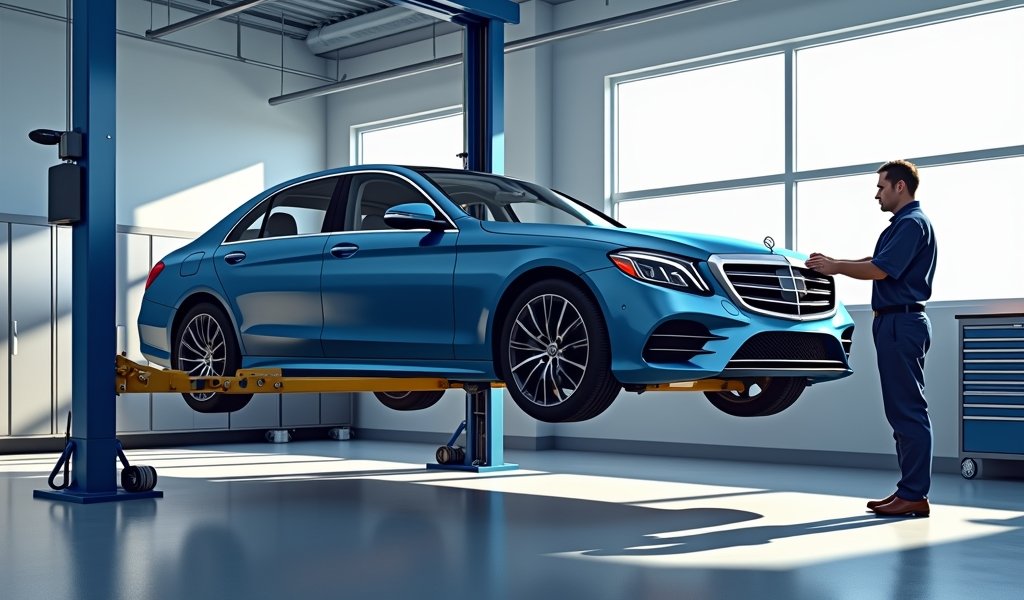Overview
Car lease mileage limits typically range from 10,000-15,000 miles annually and directly impact your costs—choosing too few miles means paying expensive overage fees (15-50¢ per mile), while higher allowances increase monthly payments but save money long-term. Understanding your actual driving needs, negotiating appropriate limits upfront, and monitoring your mileage throughout the lease are essential strategies for avoiding unexpected charges and determining whether leasing makes financial sense for your lifestyle.
Table of Contents
- Understanding Mileage Limits on Car Leases
- How Mileage Limits Work
- Standard Mileage Allowances
- How Mileage Impacts Your Lease Costs
- Calculating Your Mileage Needs
- Options for High-Mileage Drivers
- Strategies to Avoid Overage Fees
- Lease vs. Buy: The Mileage Factor
- Tips for Negotiating Better Mileage Terms
- Conclusion
- Frequently Asked Questions
Understanding Mileage Limits on Car Leases
When you’re eyeing that shiny new vehicle on the dealership lot, leasing often seems like the perfect way to get behind the wheel without the commitment of buying. But there’s one crucial detail that can turn your dream ride into a financial headache: mileage limits.
I’ve spent over 20 years in the automotive industry, and I can’t count how many folks I’ve seen hit with unexpected charges because they didn’t understand their lease’s mileage restrictions. Think of it this way – when you lease a car, you’re essentially renting it long-term, and just like a rental property, there are rules about how much “wear and tear” you can put on it.
Mileage limits are the leasing company’s way of protecting their investment – after all, they want a vehicle they can resell when you’re done with it. These limits directly impact both your monthly payments and potential end-of-lease charges, making them one of the most important factors to understand before you sign on that dotted line.
How Mileage Limits Work
Let’s break down the mechanics of mileage limits in plain English. When you lease a car, you’re basically paying for its depreciation during your lease term, plus fees and interest. The more miles you drive, the more the vehicle depreciates – it’s that simple.
Your lease contract will specify a maximum number of miles you can drive during the lease term without incurring extra charges. This isn’t a suggestion or guideline – it’s a contractual limit with financial consequences if you exceed it.
Leasing companies use these limits to predict the vehicle’s residual value – what it’ll be worth when you return it. This prediction forms the backbone of your lease’s financial structure. When you drive more miles than allowed, you’re essentially using up more of the vehicle’s value than the leasing company accounted for in your agreement.
If you exceed your mileage allowance, you’ll face overage charges calculated on a per-mile basis. These typically range from 15 to 30 cents per mile for mainstream vehicles and can jump to 50 cents or more for luxury models. That might not sound like much, but those pennies add up fast – 5,000 excess miles at 25 cents each means a $1,250 bill when you turn in your keys.

Standard Mileage Allowances
Most leases come with one of three standard mileage allowances, calculated on an annual basis:
- Low mileage: 10,000 miles per year
- Average mileage: 12,000 miles per year
- High mileage: 15,000 miles per year
For a typical 36-month lease, that translates to total allowances of 30,000, 36,000, or 45,000 miles over the full term. Some luxury manufacturers start even lower, offering base leases with just 7,500 annual miles to keep depreciation (and your monthly payment) down.
When choosing your allowance, don’t just think about your current driving habits. Consider potential job changes, moves, or lifestyle shifts that might affect your mileage during the lease term. That weekend warrior hobby or those regular visits to grandma three states over can quickly eat into your allowance.
Remember, you can always negotiate a higher mileage allowance upfront – and while it will increase your monthly payment, it’s almost always cheaper than paying overage fees later. According to a study by Edmunds, purchasing additional miles at lease signing typically costs 10-15 cents per mile versus 25-30 cents per excess mile at lease-end.
How Mileage Impacts Your Lease Costs
There’s a direct relationship between your mileage allowance and your monthly payment. Let me show you how this plays out with some real-world numbers.
For a mid-sized sedan with a $30,000 MSRP, you might see these approximate monthly payments based on mileage allowance (assuming the same term length and down payment):
- 10,000 miles/year: $325 monthly
- 12,000 miles/year: $340 monthly
- 15,000 miles/year: $365 monthly
That difference reflects the projected additional depreciation. The vehicle driven 45,000 miles over three years will typically be worth less at lease-end than one driven just 30,000 miles.
The math gets interesting when you compare the cost of a higher-mileage lease versus paying overage penalties. Let’s say you sign a 36-month lease with 10,000 annual miles at $325 monthly, but you actually drive 15,000 miles per year. You’ll end up 15,000 miles over your limit, resulting in about $3,750 in overage fees (at $0.25/mile).
Had you opted for the 15,000-mile lease at $365 monthly instead, you would have paid approximately $1,440 more over the lease term ($40 × 36 months) – saving yourself over $2,300 compared to the overage charges.
The key takeaway? Be honest about your driving needs from the start. The “cheaper” monthly payment often becomes the most expensive option if you exceed your mileage allowance significantly.
Calculating Your Mileage Needs
One of the biggest mistakes I see folks make is underestimating their driving habits. Let’s walk through how to get an accurate picture of your actual mileage needs before you sign that lease.
Start by looking at your current annual mileage. The simplest method is to check your odometer reading from exactly one year ago (maintenance records are great for this) and subtract it from your current reading.
If you don’t have that information, here’s a quick calculation to estimate your annual mileage:
- Daily commute (round trip): ___ miles × 5 days = ___ weekly miles
- Weekend driving: ___ miles per weekend
- Total weekly miles: ___ × 52 weeks = ___ base annual miles
- Add special trips (vacations, holidays, etc.): ___ miles
- Total estimated annual miles: ___
Don’t forget to account for life changes. Will you be moving? Changing jobs? Taking up a new hobby that requires travel? Planning more road trips? Even a 5-mile increase in your daily commute adds up to over 1,200 additional miles annually.
Many drivers are surprised to learn that their actual mileage is much higher than they thought. A 25-mile one-way commute equals 12,500 miles annually just for work travel (25 miles × 2 ways × 5 days × 50 weeks). Add weekend errands, social visits, and a couple of road trips, and you’re easily approaching or exceeding 15,000 miles per year.
According to the Federal Highway Administration, the average American driver logs around 13,500 miles annually – already above the standard 10,000-mile lease allowance.

Options for High-Mileage Drivers
If you’ve crunched the numbers and realized you’re a high-mileage driver, don’t worry – you’ve got options beyond just accepting hefty overage fees.
First, consider a high-mileage lease package. Many dealerships offer leases with 18,000, 20,000, or even 25,000 annual miles. Yes, your monthly payment will be higher, but it’s almost always more cost-effective than paying overage penalties.
Another option is purchasing additional miles upfront. Most leasing companies allow you to buy extra miles at the beginning of your lease at a discounted rate – typically 10-15 cents per mile versus 25-30 cents at lease-end. If you’re on the border between allowances, this can be a smart middle ground.
Some leasing companies also offer the option to purchase additional miles mid-lease if your circumstances change. While slightly more expensive than buying at signing, it’s still cheaper than overage fees.
Finally, consider whether leasing makes sense at all for your situation. If you consistently drive more than 15,000-18,000 miles annually, purchasing might make more financial sense than leasing. The break-even point varies, but generally, very high-mileage drivers (20,000+ miles annually) often find better long-term value in buying.
One creative solution some drivers use is leasing a vehicle primarily for commuting while keeping an older, paid-off vehicle for longer trips. This strategy lets you keep your leased vehicle’s mileage in check while maintaining flexibility for road trips or vacation travel.
Strategies to Avoid Overage Fees
Already in a lease and worried about exceeding your mileage limit? Don’t panic – there are several strategies to help you stay under your cap or minimize overage fees.
Start by monitoring your mileage regularly. Set a monthly reminder to check your odometer and track your usage against your allowance. Divide your total mileage allowance by your lease term in months to establish a monthly budget. If you’re consistently over budget, you’ll know early enough to make adjustments.
Consider alternative transportation when practical. Could you carpool to work once or twice a week? Take public transportation for certain trips? Ride your bike for shorter errands? Even saving 20 miles a week adds up to over 1,000 miles annually.
If you’re significantly exceeding your mileage limit, look into lease transfer options. Websites like SwapALease connect people who want to exit their lease early with those looking for a short-term lease. If you’re halfway through your term and already approaching your limit, transferring to someone who drives less could save you thousands in fees.
For multi-car households, be strategic about which vehicle you use for different trips. Save your leased vehicle for shorter journeys and use other vehicles for longer road trips when possible.
If all else fails and you’re approaching the end of your lease with excess miles, ask about purchasing the vehicle. Sometimes buying your leased vehicle at the predetermined residual value makes financial sense, especially if it’s worth less on the open market due to the high mileage. You’ll avoid the overage fees completely and own an asset you’re already familiar with.
Lease vs. Buy: The Mileage Factor
Mileage considerations should play a central role in your decision to lease or buy. Let me break down how your typical driving habits might influence this choice.
For drivers who log less than 10,000 miles annually, leasing typically provides excellent value. You’ll enjoy a new vehicle every few years with lower monthly payments than financing, and you won’t waste money on a vehicle that sits idle most of the time.
If you drive between 10,000-15,000 miles per year, either option can make sense. Compare the total cost of a lease (including any potential mileage purchases) against the cost of financing. Remember that a purchased vehicle continues providing value after the loan is paid off, while leasing means continuous payments.
High-mileage drivers (15,000+ miles annually) usually benefit more from purchasing. Not only do you avoid mileage restrictions entirely, but you also spread the vehicle’s depreciation costs over more miles driven, effectively lowering your per-mile cost of ownership.
One approach I often recommend to my clients is to consider your “cost per mile” under each scenario. For example:
- Leasing: $350 monthly × 36 months = $12,600 ÷ 36,000 miles = 35 cents per mile
- Buying: $450 monthly × 60 months = $27,000 ÷ 75,000 miles = 36 cents per mile initially, but drops significantly if you keep the vehicle beyond the loan term
This calculation becomes even more favorable toward buying as your annual mileage increases and if you keep the vehicle after it’s paid off.
Tips for Negotiating Better Mileage Terms
The good news? Mileage allowances are negotiable, just like many other aspects of a vehicle lease. Here are some practical tips from my years working with both dealerships and customers:
- Always discuss mileage needs before getting to the final paperwork. Bring it up early in negotiations, not as an afterthought.
- Be prepared to slightly increase your monthly payment to secure additional miles. Know what this is worth to you by calculating potential overage charges.
- Ask specifically about the cost per mile when purchased upfront versus as an overage. Use this difference as a negotiation point.
- Inquire about mid-lease mileage purchases and whether the dealer offers any programs to adjust your allowance during the lease term.
- Compare offers from multiple dealers. Some may be more flexible with mileage terms, especially if they’re trying to move certain models.
- Ask if there’s a grace allowance beyond your contracted limit. Some leasing companies provide a buffer of 500-1,000 miles.
During negotiations, be direct with questions like: “What happens if my driving habits change during the lease term?” or “Is there any flexibility in the mileage overage charges?” The answers can reveal how rigid or flexible the leasing company will be.
Remember that the dealership wants to make the sale. If a higher mileage allowance is important to you, be prepared to compromise elsewhere – perhaps on the down payment or accepting a different trim level – to get the miles you need within your budget.
Conclusion
Mileage limits are the hidden factor that can make or break your leasing experience. As someone who’s worked with hundreds of leasing customers over the years, I’ve seen firsthand how proper mileage planning leads to satisfied drivers and how misjudging your needs can lead to stressful, expensive lease returns.
The most important takeaways for anyone considering a lease:
- Be honest about your driving habits and realistic about future changes
- Calculate the total cost of the lease including potential mileage charges
- Negotiate your mileage allowance upfront rather than accepting standard packages
- Monitor your mileage throughout your lease term
- Consider whether leasing aligns with your driving patterns at all
Remember that the “cheapest” monthly payment often becomes the most expensive option if you exceed your mileage allowance significantly. The best lease is one that accurately reflects how you’ll actually use the vehicle.
Equipped with this knowledge, you’re now prepared to approach your next lease negotiation with confidence. You’ll understand the true costs, ask the right questions, and secure terms that work for your lifestyle – not just on paper, but for every mile of your journey.
Frequently Asked Questions
What happens if I go over my lease mileage limit?
You’ll be charged an overage fee for each mile over your limit, typically between $0.15-$0.30 per mile for standard vehicles and up to $0.50 for luxury models. These fees are due when you return the vehicle at lease-end.
Can I negotiate the mileage limit on my lease?
Yes, mileage limits are negotiable just like many other lease terms. Dealerships can offer higher mileage allowances, though this will typically increase your monthly payment.
Is it cheaper to buy extra miles at the beginning or pay overage fees later?
Purchasing miles upfront is almost always cheaper, typically costing 10-15 cents per mile versus 25-30 cents per mile for overage fees. The exact savings varies by manufacturer and model.
What’s the standard mileage allowance for most leases?
Most leases offer 10,000, 12,000, or 15,000 miles per year as standard options. The 12,000-mile allowance is the most common default option for many manufacturers.
Can I purchase more miles in the middle of my lease term?
Some leasing companies allow mid-lease mileage purchases, though typically at a higher rate than at signing. Contact your leasing company directly to see if this option is available for your specific lease.

